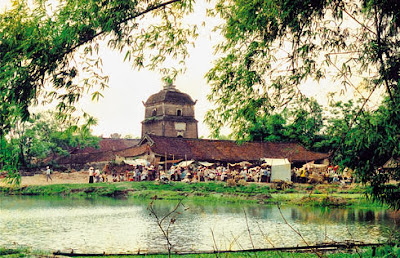Dien Bien
Area: 9,562.9 sq. km.
Population: 504.5 thousand habitants (2010).
Capital: Dien Bien Phu City.
Administrative divisions:
- Town: Muong Lay
- Districts: Tua Chua, Tuan Giao, Dien Bien Dong, Muong Tra, Muong Nhe, Dien Bien, Muong Ang.
Ethnic groups: Viet (Kinh), Thai, Mong, Dao, Giay.
 |
| Do Cat Bunker |
Geography:
Dien Bien Province is on the North - West Vietnam. It is next to Lai Chau, Son La provinces, Laos and China. The province has many mountains stretching along north-west and south-east direction. Muong Thanh Valley is largest one of this region. The topography includes forests, high mountains, narrow valleys, small plains, and springs.
Climate: Dien Bien is mountainous tropical area. There are the dry and the rainy seasons. The average temperature is about 21oC - 23oC.
Tourism:
Dien Bien possesses charming natural scenery such as Pa Khoang Reservoir, Tham Bang Cave, Ban Phu Citadel, Museum of Dien Bien Phu Victory.
Dien Bien are also proud of many historic sites: Noong Nhai Vestige, Muong Phang Forest, especially, Dien Bien Phu Vestige with a global well-known victory in 1954.
Traveling from Hanoi to Dien Bien Phu, it takes 1 hour by plane. But by road, travelers go over kilometers of mountainous road and cross Pha Din Pass. The stretch of road goes uphill and downhill alternately with many sharp bends. It is a memorable event for everybody in this superb mountain.
Dien Bien Phu City
Area: 10.94 square kilometers
Population: 70,689
Administrative Division:
Wards: Noong Bua, Him Lam, Thanh Binh, Tan Thanh, Muong Thanh, Nam Thanh, Thanh Truong.
Commune: Thanh Minh, Ta Leng
Dien Bien Phu City is 474km from north-west of Hanoi, surrounded by mountains and lies in the Muong Thanh Valley, 20km long and 6km wide heart-shaped basin. Nam Rom River runs across the valley. That is why the Muong Thanh Valley is so fertile. The Battle of Dien Bien Phu is a well-known historical event symbolizing the glorious victory of the Vietnamese people and army. After 1953, French expeditionary corps occupied Dien Bien Phu and set up a group of fortresses equipped with many state-of-the-art weapons. Dien Bien Phu Victory created a great echo in the world.
The heroic struggle of the Vietnamese people's army against the French expeditionary corps lasted for 55 days in 1954. General De Castries and his entire command were taken alive and 16,000 enemy troops were put out of action. The relics of the Battle of
Dien Bien Phu include Doc Lap Hill, the airport and the command tunnel of General De Castries. Much of the Viet Minh's brilliant strategy was planned in a 320m long tunnel, dug into a small hill, some 30km east of Dien Bien Phu. Some huts where planning sessions were held are clustered near the mouth of the tunnel, which is now overgrown with moss. A group of Thai women carrying baskets of maize drift past; war seems very far away. General Giap has been back many times to revisit this site and many of the visitors, both foreign and Vietnamese are veterans of the battle for Dien Bien Phu.
Pa Khoang Lake is actually a man-made water reservoir, crucial for the irrigation of the valley below. It is also the site of Dien Bien Phu's only tourist resort - a newly built hotel that resembles a Swiss castle. On weekends, the 21km road from Pa Khoang Lake to Dien Bien Phu is busy as the city's residents flock here for day trips. The resort is a sign of things to come as Dien Bien Phu's history continues to draw tourists.
Dien Bien Phu City is alive with colour, as the Vietnamese, Thai and H'Mong residents go about their daily affairs like carrying their wares into city, shopping in the crowded market, and holding xoe dancing parties in their stilt houses. These people, whose cultures are as different as their clothing styles, share the same warmth and hospitality for tourists. Dien Bien Phu is a historic site and the natural scenery is stunning. But it is the city's forward looking people who make a trip to Dien Bien Phu truly memorable.
Transportation:
The network of road is convenient include:- It takes 478km from Hanoi following National Highway No. 6 to Tuan Giao and then the 279 to Dien Bien Phu.- It is 195km from Dien Bien Phu to Ma Lu Thang border gate (Lai Chau) following National Highway No. 12.- The National Highway No. 279 links Tuan Giao to Tay Trang border gate vise Dien Bien Phu.
Beside that, there is Muong Thanh Airport in Dien Bien Phu, connecting Ha Noi - Dien Bien Phu.



.jpg)













































